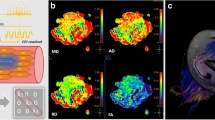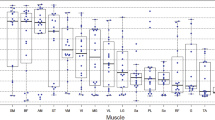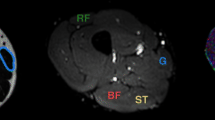Abstract
Background
There is currently a lack of suitable objective endpoints to measure disease progression in Duchenne muscular dystrophy (DMD). Emerging research suggests that diffusion tensor imaging (DTI) has potential as an outcome measure for the evaluation of skeletal muscle injury.
Objective
The objective of this study was to evaluate the potential of DTI as quantitative magnetic resonance imaging (MRI) markers of disease severity in DMD.
Materials and methods
Thirteen consecutive boys (8.9 years ± 3.0 years) with DMD were evaluated using DTI. Fractional anisotropy (FA) and apparent diffusion coefficient (ADC) were compared with clinical outcome measures of manual muscle testing and MRI determinations of muscle fat fraction (MFF) in the right lower extremity.
Results
Both MRI measures of FA and ADC strongly correlated with age and muscle strength. Values for FA positively correlated with age and negatively correlated with muscle strength (r = 0.78 and −0.96; both P ≤ 0.002) while measures of ADC negatively correlated age, but positively correlated with muscle strength (r = −0.87 and 0.83; both P ≤ 0.0004). Additionally, ADC and FA strongly correlated with MFF (r = −0.891 and 0.894, respectively; both P ≤ 0.0001). Mean MMF was negatively correlated with muscle strength (r = −0.89, P = 0.0001).
Conclusion
DTI measures of muscle structure strongly correlated with muscle strength and adiposity in boys with DMD in this pilot study, although these markers may be more reflective of fat replacement rather than muscle damage in later stages of the disease. Further studies in presymptomatic younger children are needed to assess the ability of DTI to detect early changes in DMD.


Similar content being viewed by others
References
Bushby K, Finkel R, Birnkrant DJ et al (2009) Diagnosis and management of Duchenne muscular dystrophy, part 1: diagnosis, and pharmacological and psychosocial management. Lancet Neurol 9:77–93
Hoffman EP, Brown RH Jr, Kunkel LM (1987) Dystrophin: the protein product of the Duchenne muscular dystrophy locus. Cell 51:919–928
Dubowitz V (1995) The muscular dystrophies. Muscle disorders in childhood. Saunders, London, pp 39–42
Kapsa R, Kornberg AJ, Byrne E (2003) Novel therapies for Duchenne muscular dystrophy. Lancet Neurol 2:299–310
Bogdanovich S, Perkins KJ, Krag TO et al (2004) Therapeutics for Duchenne muscular dystrophy: current approaches and future directions. J Mol Med (Berl) 82:102–115
Tidball JG, Spencer MJ (2003) Skipping to new gene therapies for muscular dystrophy. Nat Med 9:997–998
Cyrulnik SE, Fee RJ, Batchelder A et al (2008) Cognitive and adaptive deficits in young children with Duchenne muscular dystrophy (DMD). J Int Neuropsychol Soc 14:853–861
Escolar DM, Henricson EK, Mayhew J et al (2001) Clinical evaluator reliability for quantitative and manual muscle testing measures of strength in children. Muscle Nerve 24:787–793
Schrama PP, Stenneberg MS, Lucas C et al (2014) Intra-examiner reliability of hand-held dynamometry in the upper extremity: a systematic review. Arch Phys Med Rehabil. doi:10.1016/j.apmr.2014.05.019
Stern LM, Caudrey DJ, Perrett LV et al (1984) Progression of muscular dystrophy assessed by computed tomography. Dev Med Child Neurol 26:569–573
Scott OM, Hyde SA, Goddard C et al (1982) Quantitation of muscle function in children: a prospective study in Duchenne muscular dystrophy. Muscle Nerve 5:291–301
Brooke MH, Fenichel GM, Griggs RC et al (1983) Clinical investigation in Duchenne dystrophy: 2. Determination of the “power” of therapeutic trials based on the natural history. Muscle Nerve 6:91–103
Kilmer DD, Abresch RT, Fowler WM Jr (1993) Serial manual muscle testing in Duchenne muscular dystrophy. Arch Phys Med Rehabil 74:1168–1171
Brooke MH, Griggs RC, Mendell JR et al (1981) Clinical trial in Duchenne dystrophy. I. The design of the protocol. Muscle Nerve 4:186–197
Pourmand R (ed) (2004) Diagnostic tests in neuromuscular disease. Saunders, Philadelphia, PA
Marden FA, Connolly AM, Siegel MJ et al (2005) Compositional analysis of muscle in boys with Duchenne muscular dystrophy using MR imaging. Skeletal Radiol 34:140–148
Forbes SC, Walter GA, Rooney WD et al (2013) Skeletal muscles of ambulant children with Duchenne Muscular Dystrophy: validation of multicenter study of evaluation with MR imaging and MR spectroscopy. Radiology 269:198–207
Fischmann A, Hafner P, Gloor M et al (2013) Quantitative MRI and loss of free ambulation in Duchenne muscular dystrophy. J Neurol 260:969–974
Finanger EL, Russman B, Forbes SC et al (2012) Use of skeletal muscle MRI in diagnosis and monitoring disease progression in Duchenne muscular dystrophy. Phys Med Rehabil Clin N Am 23:1–10, ix
Gaeta M, Messina S, Mileto A et al (2012) Muscle fat-fraction and mapping in Duchenne muscular dystrophy: evaluation of disease distribution and correlation with clinical assessments. Preliminary experience. Skeletal Radiol 41:955–961
Gaeta M, Scribano E, Mileto A et al (2011) Muscle fat fraction in neuromuscular disorders: dual-echo dual-flip-angle spoiled gradient-recalled MR imaging technique for quantification–a feasibility study. Radiology 259:487–494
Kim HK, Laor T, Horn PS et al (2010) T2 mapping in Duchenne muscular dystrophy: distribution of disease activity and correlation with clinical assessments. Radiology 255:899–908
Wren TA, Bluml S, Tseng-Ong L et al (2008) Three-point technique of fat quantification of muscle tissue as a marker of disease progression in Duchenne muscular dystrophy: preliminary study. AJR Am J Roentgenol 190:W8–12
Hollingsworth KG, Garrood P, Eagle M et al (2013) MR imaging in Duchenne muscular dystrophy: longitudinal assessment of natural history over 18 months. Muscle Nerve 48:586–588
Kan HE, Scheenen TW, Wohlgemuth M et al (2009) Quantitative MR imaging of individual muscle involvement in facioscapulohumeral muscular dystrophy. Neuromuscul Disord 19:357–362
Basser PJ, Jones DK (2002) Diffusion-tensor MRI: theory, experimental design and data analysis - a technical review. NMR Biomed 15:456–467
Heemskerk AM, Strijkers GJ, Vilanova A et al (2005) Determination of mouse skeletal muscle architecture using three-dimensional diffusion tensor imaging. Magn Reson Med 53:1333–1340
Zaraiskaya T, Kumbhare D, Noseworthy MD (2006) Diffusion tensor imaging in evaluation of human skeletal muscle injury. J Magn Reson Imaging 24:402–408
Heemskerk AM, Damon DM (2007) Diffusion tensor MRI assessment of human skeletal muscle architecture. Curr Med Imaging Rev 3:152–160
Zhang J, Zhang G, Morrison B et al (2008) Magnetic resonance imaging of mouse skeletal muscle to measure denervation atrophy. Exp Neurol 212:448–457
Kendall HO, Kendall FP, Wadsworth GE (1971) Muscles, testing and function. Williams and Wilkins, Baltimore, MD
Ponrartana S, Andrade K, Wren TA et al (2014) Repeatability of diffusion tensor imaging for the evaluation of lower extremity skeletal muscle. AJR Am J Roentgenol 202:W567–574
Reeder SB, McKenzie CA, Pineda AR et al (2007) Water-fat separation with IDEAL gradient-echo imaging. J Magn Reson Imaging 25:644–652
Bley TA, Wieben O, Francois CJ et al (2010) Fat and water magnetic resonance imaging. J Magn Reson Imaging 31:4–18
Kim HK, Laor T, Horn PS et al (2010) Quantitative assessment of the T2 relaxation time of the gluteus muscles in children with Duchenne muscular dystrophy: a comparative study before and after steroid treatment. Korean J Radiol 11:304–311
Kermarrec E, Budzik JF, Khalil C et al (2010) In vivo diffusion tensor imaging and tractography of human thigh muscles in healthy subjects. AJR Am J Roentgenol 195:W352–356
Sinha S, Sinha U, Edgerton VR (2006) In vivo diffusion tensor imaging of the human calf muscle. J Magn Reson Imaging 24:182–190
Galban CJ, Maderwald S, Uffmann K et al (2005) A diffusion tensor imaging analysis of gender differences in water diffusivity within human skeletal muscle. NMR Biomed 18:489–498
Budzik JF, Le Thuc V, Demondion X et al (2007) In vivo MR tractography of thigh muscles using diffusion imaging: initial results. Eur Radiol 17:3079–3085
Qi J, Olsen NJ, Price RR et al (2008) Diffusion-weighted imaging of inflammatory myopathies: polymyositis and dermatomyositis. J Magn Reson Imaging 27:212–217
Williams SE, Heemskerk AM, Welch EB et al (2013) Quantitative effects of inclusion of fat on muscle diffusion tensor MRI measurements. J Magn Reson Imaging 38:1292–1297
Conflicts of interest
Dr. T. G. Perkins and Mr. J. M. Chia are employees of Philips Healthcare.
Author information
Authors and Affiliations
Corresponding author
Rights and permissions
About this article
Cite this article
Ponrartana, S., Ramos-Platt, L., Wren, T.A.L. et al. Effectiveness of diffusion tensor imaging in assessing disease severity in Duchenne muscular dystrophy: preliminary study. Pediatr Radiol 45, 582–589 (2015). https://doi.org/10.1007/s00247-014-3187-6
Received:
Revised:
Accepted:
Published:
Issue Date:
DOI: https://doi.org/10.1007/s00247-014-3187-6




